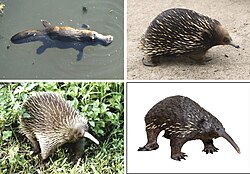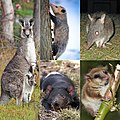The evolution of mammals has passed through many stages since the first appearance of their synapsid ancestors in the Pennsylvanian sub-period of the...
141 KB (14,966 words) - 16:00, 21 July 2025
Monotreme (redirect from Evolution of monotremes)
Monotremes (/ˈmɒnətriːmz/) are mammals of the order Monotremata. They are the only group of living mammals that lay eggs, rather than bearing live young...
46 KB (4,635 words) - 15:35, 18 July 2025
Ungulate (redirect from Evolution of ungulates)
"Condylarths: Archaic hoofed mammals" in Paleocene mammals of the world Savage, RJG, & Long, MR (1986). Mammal Evolution: an illustrated guide. New York:...
59 KB (5,864 words) - 18:43, 29 July 2025
A mammal (from Latin mamma 'breast') is a vertebrate animal of the class Mammalia (/məˈmeɪli.ə/). Mammals are characterised by the presence of milk-producing...
220 KB (23,231 words) - 06:09, 21 July 2025
Marine mammals are mammals that rely on marine ecosystems for their existence. They include animals such as cetaceans, pinnipeds, sirenians, sea otters...
127 KB (13,311 words) - 07:18, 25 June 2025
prostate evolution in monotreme mammals. Testicular descent occurs to a variable degree in various mammals, ranging from virtually no change of position...
6 KB (751 words) - 23:14, 19 December 2023
Z, Cifelli RL (2004). "Chapter 3: Origin of mammals". Mammals from the age of dinosaurs: origins, evolution, and structure. New York: Columbia University...
40 KB (4,284 words) - 03:44, 26 May 2025
Davis, R. W. 2019. Return to the Sea: The Evolution of Marine Mammals. Pages 7–27 in R. W. Davis, ed. Marine Mammals: Adaptations for an Aquatic Life. Springer...
84 KB (9,890 words) - 15:28, 11 July 2025
Marsupial (redirect from Evolution of marsupials)
diverse group of mammals belonging to the infraclass Marsupialia. They are natively found in Australasia, Wallacea, and the Americas. One of marsupials'...
73 KB (7,295 words) - 08:54, 1 August 2025
Theria (redirect from Therian mammals)
(thēríon) 'wild beast') is a subclass of mammals amongst the Theriiformes. Theria includes the eutherians (including the placental mammals) and the metatherians (including...
12 KB (1,070 words) - 20:35, 18 July 2025
of similar placental and marsupial forms is described by Richard Dawkins in The Blind Watchmaker as a case of convergent evolution, because mammals on...
59 KB (5,838 words) - 19:20, 31 July 2025
Synapsida (redirect from Proto-mammals)
"reptile", so they are now referred to as stem mammals, proto-mammals, paramammals or pan-mammals. Most lineages of pelycosaur-grade synapsids were replaced...
60 KB (6,044 words) - 01:11, 12 June 2025
The monotremes (egg laying mammals) represent the order of extant mammals most distantly related to humans. The platypus (Ornithorhynchus anatinus) is...
8 KB (907 words) - 14:01, 16 April 2024
relatives. They are the only extant herbivorous marine mammals and the only group of herbivorous mammals to have become completely aquatic. Sirenians are thought...
10 KB (1,058 words) - 05:03, 20 May 2025
Feliformia (redirect from Evolution of feliform mammals)
Handbook of the Mammals of the World, Volume 1: Carnivora. Barcelona: Lynx Ediciones. pp. 50–658. ISBN 978-84-96553-49-1. Barycka, E. (2007). "Evolution and...
21 KB (2,195 words) - 04:47, 20 July 2025
Caniformia (redirect from Evolution of caniform mammals)
group of semiaquatic marine mammals which is closely related to an extinct group of pinnipeds, Enaliarctos. While support for the monophyly of pinnipeds...
20 KB (1,975 words) - 04:47, 20 July 2025
Aquatic mammals and semiaquatic mammals are a diverse group of mammals that dwell partly or entirely in bodies of water. They include the various marine...
69 KB (8,018 words) - 02:54, 20 July 2025
Eupelycosauria (section Evolution)
fossils of Echinerpeton and perhaps an even earlier genus, Protoclepsydrops, representing just one of the many stages in the evolution of mammals, in contrast...
10 KB (775 words) - 06:12, 26 May 2025
Polyphyodont (section Evolution in mammals)
elephants and kangaroos are unusual among mammals because they are polyphyodonts, in contrast to most other mammals which replace their teeth only once in...
7 KB (795 words) - 03:55, 5 March 2025
Spine (zoology) (section Spine evolution in mammals)
linked to dietary habits, specifically those of insectivorous mammals. Myrmecophagous mammals, mammals which primarily eat ants and termites, typically...
17 KB (2,024 words) - 13:08, 30 June 2025
domesticated mammals, domesticated cat breeds have very few genetic differences from their wild counterparts due to constant intermixing, with thousands of years...
19 KB (2,226 words) - 16:22, 17 July 2025
humans and close relatives such as chimpanzees. Females of other species of placental mammals undergo estrous cycles, in which the endometrium is completely...
20 KB (2,106 words) - 17:11, 23 May 2025
group of eupelycosaurian synapsids that includes mammals and their ancestors and close relatives. Many of the traits today seen as unique to mammals had...
30 KB (2,943 words) - 02:14, 30 July 2025
Placentalia (redirect from Evolutionary history of placental mammals)
other mammals. (Their function in non-placental mammals is to stiffen the body during locomotion, but in placentals they would inhibit the expansion of the...
27 KB (2,644 words) - 10:53, 30 June 2025
small mammals. Thus, the large mammal tend have longer gestation periods than small mammal as they tend to produce larger neonate. Large mammals require...
37 KB (1,451 words) - 06:21, 19 July 2025
concretions, and made unprecedented finds documenting the rise and early evolution of mammals. Scholia has a profile for Tyler Lyson (Q7860071). Carroll, Sean...
8 KB (968 words) - 12:58, 7 July 2025
Cenozoic (redirect from Age of mammals)
Southern Hemisphere. The extinction of many groups allowed mammals and birds to greatly diversify so that large mammals and birds dominated life on Earth...
36 KB (3,808 words) - 07:17, 5 July 2025
further removed from crown group mammals than Hadrocodium, had two layers of fur, guard hairs and underfur, as do mammals today. It is possible that early...
21 KB (1,736 words) - 10:06, 25 May 2025
Megafauna (redirect from Evolution of megafauna)
around 50,000 years ago onwards, most large mammal species became extinct, including 80% of all mammals greater than 1,000 kilograms (2,200 lb), while...
79 KB (8,098 words) - 18:26, 2 August 2025
Semelparity and iteroparity (redirect from Evolution of semelparity)
The evolution for semelparity in both sexes has occurred many times in plants, invertebrates, and fish. It is rare in mammals because mammals have obligate...
37 KB (4,526 words) - 17:11, 3 June 2025























